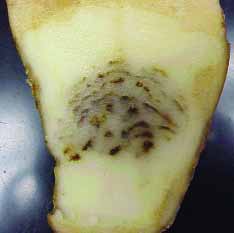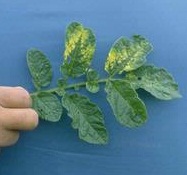Pomovirus sp.
Potato Mop-Top Virus (PMTV)
Synonym: Carlavirus sp.
Group: IV: ssRNA positive-strand viruses
Family: Flexiviridae


Photographer: William M. Brown Jr.
Source: http://extension.umaine.edu/ Source: bugwood.org
Description
The genus Pomovirus is created specifically for the Potato Mop Top Virus (PMTV). This virus is vectored not by an insect but by another pathogen: Spongospora subterranea f. sp. subterranea, is a soil-borne organism that causes of “powdery scab disease” which occurs worldwide. By Pomovirus being transmitted by such a cosmopolitan vector like S. subterranean it is able to spread easier.
Symptoms: Tuber symptoms, which are called “spraing” is the rust-brown discoloration in the shape of arcs or rings that appear internally on the potato. Spraing usually appear more after harvest and when the potatoes are stored but overall tuber symptoms are not commonly found. Leave and stem symptoms only appear if the seed planted is infected; these symptoms vary depending on weather and season. Leave and stem symptoms are favored by cool weather and may fade as the season becomes hotter. A yellow both pattern can appear on the lower leaves or as a V-shaped pattern or internode shortening (mop-top). The picture above shows the spraing (left) and the yellow leaf mottling (right).
Host Plant: Potato (Solanum tuberosum) but tomatoes, black nightshade and ground cherry can also be hosts.
Ecological Threat: Yield losses can be up to 20% in highly sensitive cultivars, and has been extensively studied in the Pacific Northwest in recent years. Results of these studies indicate where the potatoes are grown has much to do with the amount of yield loss that occurs. The impact due to PMTV is much reduced if grown in shorter season areas of Idaho and Oregon compared to if grown in the long season and high yielding areas of the Columbia Basin. Potatoes are such a vital crop and PMTV can be hard to detect; this combination makes for a large economic and ecological threat.
Biology: High levels of soil moisture and cool soil temperatures (12-20°C) stimulate the fungal spores to germinate and release virus-carrying zoospores that need free water for movement. Zoospores introduce the virus into the potato plant when they infect the roots, stolons and/or young tubers. The critical period for infection and development of “powdery scab” on tubers is early in the growth cycle, a period that lasts about 3-4 weeks. Tubers which have matured beyond this period are resistant to infection by zoospores. Little or no spread occurs in areas where soil temperatures are above 20°C, or where moisture is lacking. Since roots can be infected by S. subterranea, even cultivars noted for some resistance to powdery scab may still be infected with PMTV.
When PMTV-infected tubers are planted as seed, the virus is passed on as a secondary infection to only limited numbers of progeny tubers (30 - 50%). Therefore, spread via the obligate vector, “powdery scab” is the most important means of transmission. Also PMTV is known to survive in the soil 18 years without the host plant.
History: PMTV was first reported in Europe around 1966 and from Canada in 1992. Until 2001, PTMV was found primarily in cooler growing regions around the world. It was detected in a few lots of processing potatoes from Idaho, Oregon, and Washington in 2001. By 2011, it was confirmed in North Dakota. This virus has now been confirmed in many potato production areas in the United States and is commonly found where powdery scab is present.
U.S. Habitat: Soil with high moisture levels and temperatures under 20oC.
Distribution
Native Origin: Europe
U.S. Present: ID, ME, ND, OR, WA
Management
Planting certified seed potatoes reduces the risk of all potato diseases, including PMTV and powdery scab. However, potatoes from locations with a history of PMTV and powdery scab may have a higher risk of carrying the disease. Good weed management minimizes the possibility of wild hosts acting as a reservoir for the virus. Once both vector and virus are established in a field, PMTV is difficult to eradicate.
Apart from varietal selection and certification programs designed to detect or flush out viruses, control of PMTV is generally directed at its vector, S. subterranea. Infection may be reduced, in some cases, by improving drainage, reducing irrigation during early tuber development, and delaying planting until soils are warmer or drier. Seed treatments may help reduce the spread of the pathogen from infected seed. Soil treatments may reduce numbers of viable spores. No maximum survival time has been determined for powdery scab spores. Some reductions in powdery scab have been reported in rotations with brassicas and datura (a weed). While the powdery scab organism and PMTV are reported to persist in soil for more than a decade, longer rotations will reduce the severity of scab, and therefore reduce the transmission of PMTV.
References
Harrison, B. D., & Jones, R. A. C. 1970. Host range and some properties of potato mop‐top virus. Annals of applied Biology, 65(3), 393-402.
Jones, R. A. C., & Harrison, B. D. 1972. Ecological studies on potato mop‐top virus in Scotland. Annals of applied Biology, 71(1), 47-57.
Whitworth, J. L., & Crosslin, J. M. 2013. Detection of Potato mop top virus (Furovirus) on potato in southeast Idaho. Plant Disease, 97(1), 149-149.
Internet References
http://viralzone.expasy.org/all_by_species/643.html
http://extension.umaine.edu/publications/2437e/
http://www.agri.state.id.us/Categories/Environment/InvasiveSpeciesCouncil/InvSppList.php
http://pnwhandbooks.org/plantdisease/potato-solanum-tuberosum-potato-mop-top-virus
Back to Invasive Parasites and Diseases
 Texas Invasive Species Institute
Texas Invasive Species Institute